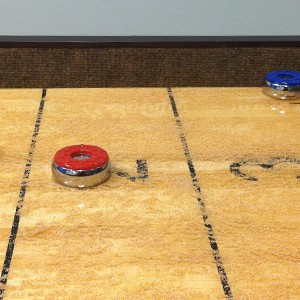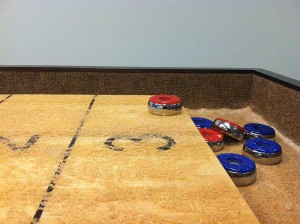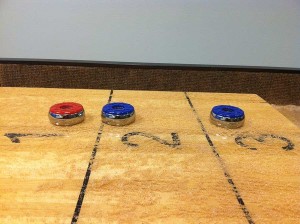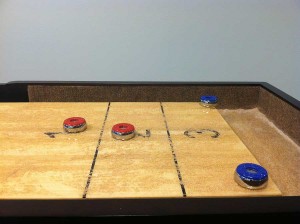
The Strategy of Throwing Shuffleboard Weights
If you’ve played on shuffleboard tables, then you know that there’s more to a game of shuffleboard than you might initially think. It’s all about the shuffleboard weights. To be more specific, it’s all in how you throw your shuffleboard weights. As in any other game, understanding strategy is key to dominating the competition. While there are many shuffleboard games, there are many styles of gameplay that can improve your shuffleboard skills overall.

Knock Off Strategy
This concept may sound simple, but it does require skill. If you knock off each of your opponent’s shuffleboard weights after each shot, they won’t be able get any points. By attacking your opponent’s weights you are increasing the chance that you will knock all their weights off the board. Manage to leave one of your pucks on the shuffleboard table and you will win the round by (almost) default after successfully grinding out your opponent in this super defensive strategy.

The Corner Strategy
Where you send your shuffleboard weights on the board is a critical part of the strategy. Since the highest-scoring part of the board is at the end, you will want to send as many weights into this zone as possible. However, another gameplay method involves placing two of your shuffleboard weights on the far corners of the board. You should especially try this if you shoot first and if your opponent does not knock your weight off. Having weights at each corner of the board makes it difficult for your opponent to remove both of your weights from scoring position.

The Blocking Strategy
Another useful shuffleboard strategy involves using your shuffleboard weights as blocking mechanisms. In Knock Off you get the most points for weights that are farthest down the table, so once you have thrown your ideal shot, you will want to block the weight with your next shot. Carefully shoot your weight down the board so that you can surround and block, but don’t come too close. An expert shuffleboard player knows how to hit two pucks off that are close in a single shot. Don’t make things easier on your competition.

The Multi Hand Strategy
Another technique that will tremendously improve your gameplay is learning how to throw the shuffleboard weights with either hand. To develop better skill with controlling the speed and the arrangement of the weights, hold the weight with one hand and slide it along either side of the board. Then do the same thing using the other hand. It’s recommended to practice the different types of shots with both hands so that you can build muscle memory in both hands. Although it will take a bit of a time investment to practice like this, it will sharpen your abilities and make you a better player in the long run.
Whether you desire to become the shuffleboard authority in your house or you just want to get a little bit better at the game, the first step is understanding your shuffleboard weights. Rather than just throwing your pucks willy-nilly and hoping for the best, you can actually control their positioning by the way you hold and shoot the weight. Shuffleboard tables can exist in varying conditions from your home to the bar to the arcade, but if you know how to throw your shuffleboard weights, you can command any game on any table.



Is there more to it than that? Or is that the whole game?
I was hoping for something deeper but i can’t find it anywhere.
This is about strategy of how to throw the weights they have lots of games you can learn to play here https://www.mccluretables.com/t-Shuffleboard_Game_Rules.aspx
Seems like shuffleboard strategy depends a lot on your opponent.
What are they good at?
What kind of game are THEY trying to play?
For instance, it takes two to play complicated positional play (or they have to miss a shot), but if either player wants to play the take-out game, then both have to play it.
If you are ahead, playing the takeout game is great with or without hammer, so long as you can score more than one when you have the hammer, and so long as they are inconsistent at getting more than one with hammer. But once you get behind, this sort of attritional tit for tat can be counterproductive, because you will never get a big score. this is really dangerous if you have a low hit percentage on your throws, because you let them build up board presence. in a similar way, if your opponent has poor aim, you can tattoo them with a ton of points.
Corner/side placement is another way to play that potentially leads to bigger scores. If you have the hammer, sticking pucks to the sides of the board means you can get counting pucks into play and still leave the center open for your last throw. If you ever get to make a throw while your puck is in a high scoring position, you can switch to guarding, and put some pressure on them. keep the guards tight enough that they can defend multiple angles, but far enough back that double take-outs are not easy. If your opponent has the hammer, throwing towards the sides of the board can be a first step in clogging up the area short of the big points. this sort of play can make it very difficult for them to score more than one point. the risk in playing sides is that you leave the center open for them. if your opponent is good at taking out pucks in the middle, but struggles to get the sides, this becomes a better strategy.
Playing in the center is the last option. For the person with the hammer, it is simply not recommended. you are clogging up your own board, and giving them easy shots. if you throw short, you give them the chance to curl behind your puck with protection. But if you are throwing first, center shots can be effective. it’s the fastest way to enact a clog-up-the-center strategy. The risk is when you throw short, because you are basically throwing pucks for your opponent if you let them easily come in behind you. You’ve got to throw these center pucks far down the board.
—
So how do you pick a strategy?
Well, watch your opponent and see what shots he makes, and which one he misses. mix things up and have a versatile game. start with the strategies that are low risk to you to get the hang of the table before trying riskier strategies. A reason to minimize risk is to keep yourself flexible. Your options decrease as you fall behind.
Thanks for the tips, I’m going to practise with both hands tonight